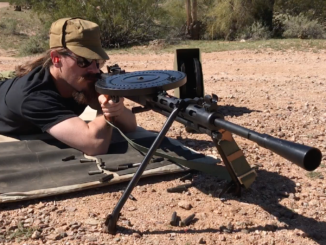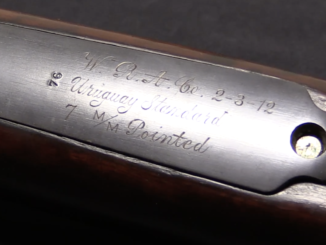In 1855, Prussian customs officials discovered a shipment of 3,000 Colt 1851 Navy model revolvers (and their accouterments) hidden in bales of cotton being shipped from New York to Russia. Prussia was a neutral power in the ongoing Crimean War, but had prohibited transit of arms across its borders. Squeezed by a British blockade of its ports in the Baltic, Russia tried to being in these pistols through Prussia anyway, and was caught (much to the embarrassment of Colt, who was trying to sells his revolvers to the British at the same time).
After three years of stalling, the Prussian government decided to keep 1,000 of the revolvers for issue to its own navy, and sell the remaining 2,000 at auction. The navy revolvers and their accessories (powder flasks and cappers) were stamped with “KM” (Königliche Marine, or Royal Navy) and sequential inventory numbers. They would be the first repeating pistols issued to the Prussian Navy.




“Prussia was a neutral power in the ongoing Crimean War…”(C)
But she did not miss the opportunity to lay her paw on someone else’s property. LOL
He and His. LOL
Neutral does not mean passive. They said no transit of weapons through their land. Smuggling the weapons rendered them contraband. Contraband gets confiscated. Suppose Prussia was shipping guns to the Emperor Maximilian and Uncle Sam sized the weapons. If Bismarck griped you’d rightly call him a sissy bit*h.
I like that holster!! I like the thought of it anyway, as it would prob be a pain to keep the weapon secured correctly. It would be a good hunting holster (minus the spare cylinder holster)
Very nice Colt 3rd model Navy revolver.
Two questions jump to mind:
1. Where did the Prussians come up with 1,000 extra cylinders? Did they cannibalize half of the remaining 2,000?
2. The capping tool seems worthy of its own video. Where these standard for civilian or U.S. military Colts? How were they used? I’m guessing they would hold six, or perhaps 12 caps so you wouldn’t be fumbling in an open box for one at a time.
As the prussian sold the other 2000, I doubt the pocket was for a spare cylinder. It was probably for bullets or packets of paper cartridges.
This.
As the service pistol used to be a single-shot before that I bet some officer feared waste of ammo by seamen blasting away. So a packet of spare cartridges and/or other tools.
The pouch was for a box of 12 cartridges. There were no spare cylinders.
This capping tool was manufactured by the Prussians for their next Navy revolver, the double action M1869. They made identical ones for the Colts which can be identified by a number stamped after the KM.
I’m sure colt was more than willing to sell them spare cylinders.
Yes, and I’m sure nobody would object to having spare parts if heavy usage occurred. Heavy usage as in firing without rest or having to use the revolver as a club on a daily basis.
Ian,
why don’t you post new videos on Full30.com any more?
The last one was uploaded there in August…
The Colt design does not allow for reloading by replacing the cylinder.
In this case, in fact, the revolver must be disassembled in half. At the risk of losing details.
Without much difference, sitting on a horse or in a dark ship’s hold.
These revolvers are actually six shots. In the sense that after using up six bullets, you are out of the battle to reload.
Therefore, in fact, they carried two revolvers.
It looks like a pocket for a second cylinder, but it doesn’t fit.
I haven’t heard these Colt revolvers come with two cylinders.
Is it possible that the order was completed from stock and the holster came from the old model?
Like the rest of the mix.
“…Captain Arnold, Lieutenants Meinel and Burke. As soon as they stepped ashore, they opened a hurricane of fire from revolvers.
Burka was attacked by six Russian infantrymen. He neutralized two of them with revolver shots, and threw the third with a saber. Having shot the drum of one revolver, he used the second, but was caught by the attackers and killed. Later, more than thirty wounds from edged weapons were found on his body.”(C)
Tyrrell, Henry. The history of the war with Russia: giving full details of the operations of the allied armies. Vol.1. London. 1855. p.146
“The case has been checked, when in the interim due to the anti-tank alert, 145
Skirmishers with an edge and a capsule.
In its own list with a demo
Samuel Golut indicates that I was asked to pay 100,000 dollars, so that
Delete this script.”(C)
https://cyberleninka.ru/article/n/samyuel-kolt-v-sankt-peterburge/viewer
Encoding problems …
This case is mentioned here. About the detention of 3481 revolvers in 145 cotton bales by the Antwerp customs.
And that Samuel Colt had to pay $ 100,000 (!) To avoid a scandal.
No wonder this factory is plagued by scandals.
It is vicious from birth.
A lot more about such revolvers.
https://panzer038.livejournal.com/1385570.html
I looked into cylinder swap. Owners of the 1851 Colt Navy say it can be done in about 25-30 seconds. Not easily or smoothly but it can be done.
Under combat conditions I’m guessing it takes longer. Shaking hands, dropped stuff… I could be right.
To be the nitpicky german (;-)): it is “königlich-preußische Marine”, but within Prussia it was of course just königlich. No other King in Prussia. The flag is only half correct, because the royal prussian navy used thie depicted flag, but with an iron cross in the upper left.
I find it surprising, that the prussian navy was so easily taking these confiscated revolvers into service. But why did they not stockpile all of them for wartime?
Keeping in mind the later German habit of mounting the spare magazine pouch on the holster itself, perhaps that pouch is not for a spare cylinder but spare paper cartridges? If they went to the trouble of having the capping tool on the holster, and the cylinder is a pain to replace (unlike the Remingtons), perhaps that cylinder pouch is a cartridge box with the insert missing? If a spare loaded cylinder was carried uncapped (for safety reasons), wouldn’t it be easier just to carry a powder flask and bullets considering the complexity of both swapping out and then capping the new cylinder?
Exactly what I said before
This is the pocket for the spare cylinder. It has a pull strap.
Perhaps it was planned to produce the missing parts on their own.
They tried to do it in Russia. By that time, Counterfeit copies of Colt revolvers were already being manufactured in Russia (at the beginning of 1855, 300-400 pieces were manufactured), so making cylinders should not have been a problem.
In theory.
In reality, the quality of the clones was much worse than the originals. And the quality of the metal, and the build quality, and ballistic properties. Russian revolvers did not shoot well with conical bullets, due to incorrect grooves in the barrel.
And there could be no question of complete interchangeability of parts. If some of the parts fit other revolvers, it was only by accident.
https://forum.ww2.ru/uploads/monthly_08_2017/post-78720-0-54875900-1503168832.jpg
That’s in much better shape than my well used reproduction! Not even a lot of holster wear, it must have been stored away most of it’s existence. I love that holster! It’s very pragmatic. Of course, US flap holsters were purely functional for protecting susceptible tools in field conditions, and fitting that function into a budget.